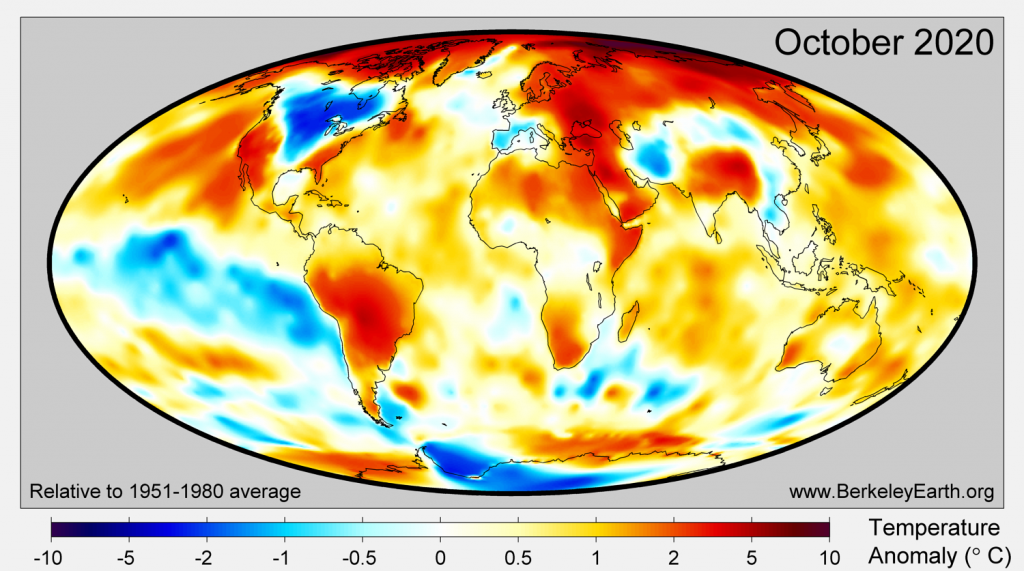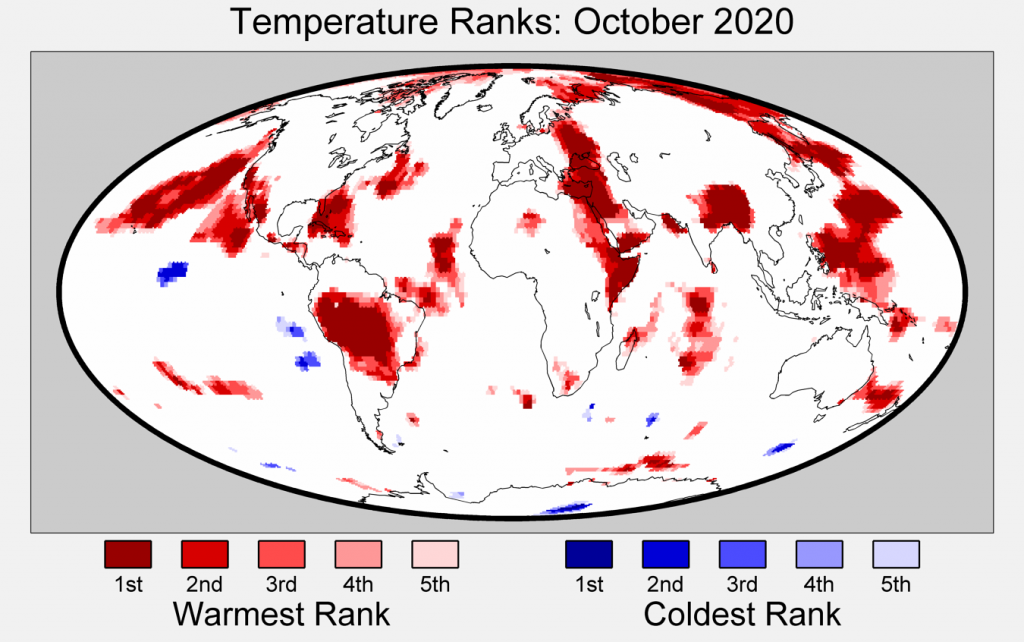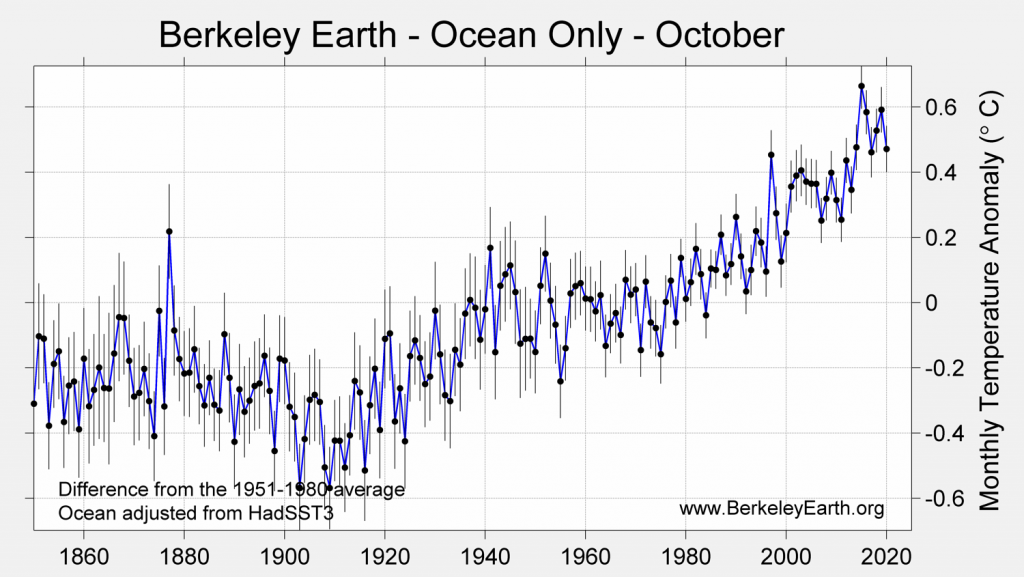The following is a summary of global temperature conditions in Berkeley Earth’s analysis of October 2020.
- October 2020 was the 5th warmest October since records began in 1850.
- A moderate La Niña has strengthened in the Pacific, reducing temperatures from September.
- Very warm conditions occurred over most of the Arctic, coincident with very record low sea ice extent for October.
- With 10 months completed, 2020 is now slightly behind 2016 as the warmest year since instrumental measurements began.
- A relatively cool October and stronger La Niña has sharply reduced the odds that 2020 will be a record warm year. We estimate only a 16% chance that 2020 ends as the warmest year, and a 80% chance that it finishes as the second warmest year.
Global Summary
Globally, October 2020 has been the fifth warmest October since records began in 1850. This is similar to other recent years, but appreciably lower than in 2019 and 2015. This is the first month in 2020 that has been ranked lower than the fourth warmest. Previously in 2020, April, May, June, July, and September have each been record warm or tied the previous record.

The global mean temperature in October 2020 was 0.85 ± 0.07 °C (1.53 ± 0.12 °F) above the 1951 to 1980 average.
This is equivalent to being 1.18 ± 0.08 °C (2.12 ± 0.14 °F) above the 1850 to 1900 average, which is frequently used as a benchmark for the preindustrial period.
The global mean temperature anomaly in October 2020 was a tick downward from September, though still similar to July and August. The current values remain close to the long-term trend line associated with recent global warming.

Spatial Variation
October 2020 continues the ongoing pattern of wide-spread warmth, though with some notable exceptions. Particularly warm conditions were present in parts of Asia, Western Europe, the Middle East, and South America. Record setting warmth was also present in parts of the Northern and Western Pacific. Significantly cool temperatures occurred in parts of the Eastern Pacific and North America.
We estimate that 5.8% of the Earth’s surface experienced their locally warmest October average, and 68% of the Earth’s surface was significantly warmer when compared to their local average during the period 1951 to 1980. In addition, 0.02% of Earth’s surface had their locally coldest October.
The cool area in the Eastern Pacific, first observed in June, substantially increased in October. This is indicative of strengthening La Niña conditions.


Over land regions, 2020 was the fifth warmest October, coming in as 1.36 ± 0.14 °C (2.45 ± 0.25 °F) above the 1951 to 1980 average.
Influenced by the growing La Niña, October 2020 was merely the sixth warmest October in the oceans, recorded as 0.47 ± 0.07 °C (0.85 ± 0.11 °F) above the 1951 to 1980 average.
During October, both land and ocean recorded their lowest rank position of 2020.


Arctic Ocean
Highly elevated temperatures were present across much of the Arctic Ocean, up to nearly 12 °C above the 1950-1980 average. In many cases, these were not quite records for October, but they were associated with record low sea ice for October, with the warmest areas associated with unusual regions of open water. Whereas warm Arctic weather in the spring and early summer originally drove sea ice declines, the causality is now reversed. At this point, the persistent areas of open water are largely responsible for causing the warm air temperatures.


In addition, the unusually low sea ice extent allowed for the Northeast Passage through the Arctic Ocean, along the Siberian Coast, to remain open for a record length of time. This year witnessed both the earliest date of an open seaway in the Arctic and the latest closing of such a passage. Thirty years ago, many years never experienced open water conditions at all. This year, the passage from the Atlantic to the Pacific remained open for a record 112 days.

California
While most of the United States had below average temperatures in October, it is worth noting that California was at record highs in October. The potential for wildfires in California is strongly influenced by the weather conditions during May to October. During hot & dry years, the native vegetation can become highly flammable contributing to the spread and intensity of wildfires. All ten of the largest and most destructive wildfires in California history occurred during fire seasons that were hotter and drier than average.
This year was, by far, the warmest such period on record for California. Combined with below average rainfall, vegetation in California has been extremely vulnerable to fire this year. This contributed to a record-breaking 4.2 million acres (17,000 km²) of wildfire so far in 2020. This is more than double the previous record. In addition 5 of the 6 largest fires ever recorded in California history occurred this year.

Weather conditions, and by extension climate change, are not the only factors affecting wildfires in California. Forest management practices and the encroachment of settlements on wild lands have also played a significant role. However, climate change has been a major factor in the intensifying of wildfires during recent years.
La Niña
October 2020 showed a strengthening and consolidation of La Niña conditions in the Pacific Ocean. This weather phenomenon is characterized by the emergence of relatively cool ocean water in the Eastern Central Pacific and would be expected to have a cooling impact on global weather patterns over the next several months. Currently, La Niña has increased from weak to moderate intensity. It is expected to peak this winter, and some forecasts point towards a strong La Niña.
La Niña conditions this fall and winter would be expected to reduce global mean temperature towards the end of 2020 and in first half of 2021.

2020 January to October Summary
After 10 months, the Earth in 2020 has been marked by above average temperatures nearly everywhere, with especially extreme conditions across Northern Asia. We estimate that the January to October average has been record warm for 10.9% of the Earth, and appreciably above the 1951 to 1980 average for 87% of the Earth. Only, 1.0% of the Earth’s surface was significantly cooler than the 1951 to 1980 average during the current January to October period, and no locations were record cool.
In addition, the January to October averages for Asia, South America, and Europe have set new record highs.

Looking at regions where January to October temperature averages were either the top 5 warmest or the top 5 coldest observed, we note extensive regions with record or near-record warmth during the first ten months of 2020 and no regions of near-record cold.

Rest of 2020
Of the first ten months of 2020, April, May, June, July, and September each set or tied a record for warmth. Other months were each no lower than the fifth warmest. However, the intensification of La Niña and relatively mild October have had a downward effect on predictions for the annual average.
Overall, the January to October average is now slightly behind the pace set in 2016, which was the warmest year on record.

The projected warmth during the end of the year remains quite high. However, the strengthening La Niña event expected to peak this winter suggests that temperatures at the end of 2020 may be cooler than previously expected.
The statistical approach that we use now believes that 2020 has only a 16% likelihood of surpassing 2016 and becoming the warmest year that has been directly measured. This is sharply lower from the previous forecast that placed the odds of a new record at 57%. This decrease in probability is driven by the relative cooling in October and the strengthening of the ongoing La Niña.
Events with a 16% likelihood still occur about 1 time out of 6, and a new record remains possible. However, the unexpected magnitude of the current La Niña now makes it unlikely that 2020 will set a record for warmest year.
Regardless of whether a new record is set, it remains highly likely that 2020 will be either the warmest or second warmest year since 1850.

Likelihood of final 2020 ranking, based on January to October:
- 1st place (16%)
- 2nd place (80%)
- 3rd place (4%)
- Top 3 overall (>99%)
As 2020 has progressed, the uncertainty on the final average for the year has predictably narrowed. If we examine this change over time, we note that early in the year odds of a new record were somewhat above 50%, albeit with low confidence. This dropped sharply in June when hints of a transition to La Niña developed, but a new record continued to have a substantial likelihood, buoyed by a series of record warm months. The odds of a new record again moved slightly above 50% following the record warm weather in September, before now dropping again as La Niña has intensified in October.



